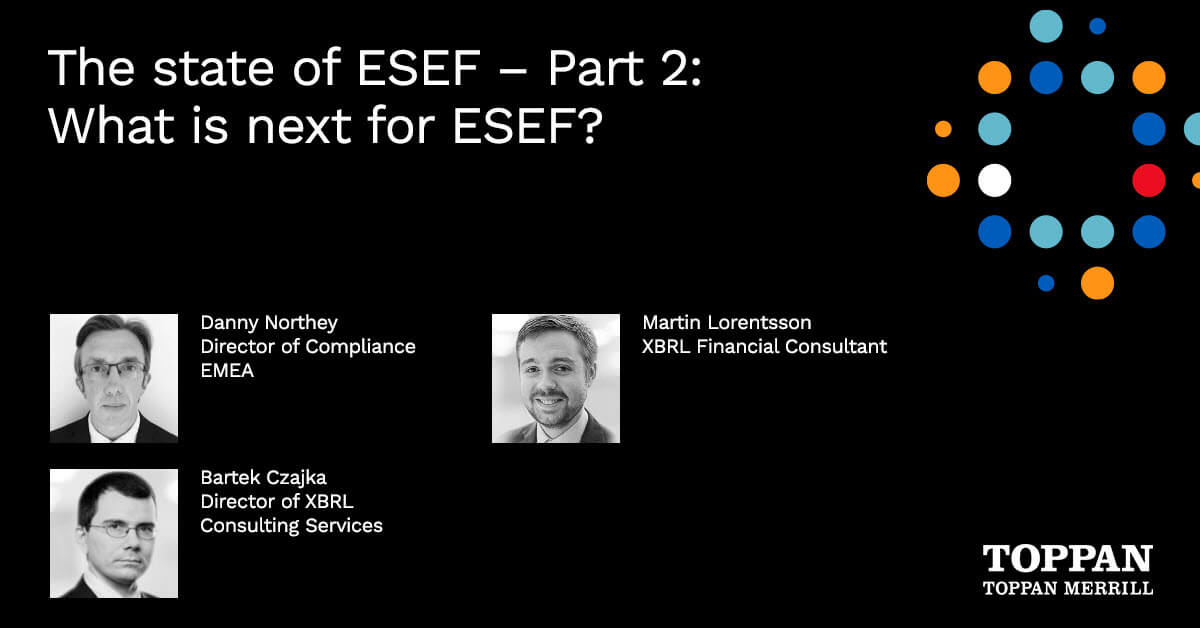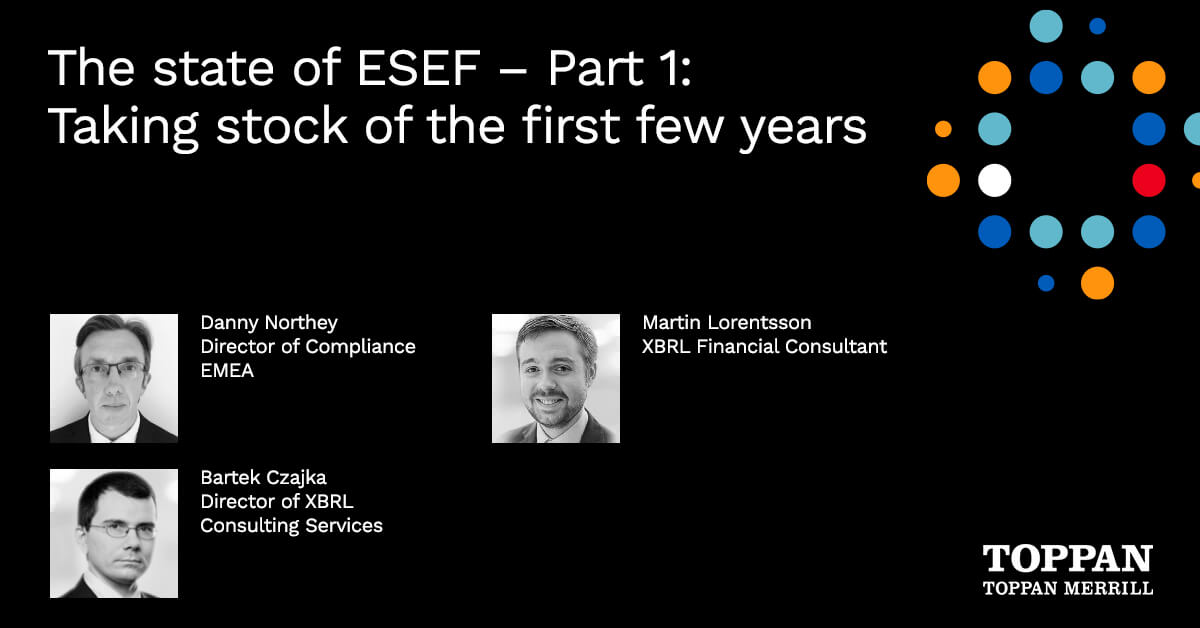1. What is block tagging in XBRL for ESEF reporting?
For the purposes of the ESEF requirements, the concept of block tagging means marking up pieces of information in the company’s financial statements using specific XBRL tags that are defined with the property “textBlockItemType”. The tags mark up blocks of content, without individually marking up any numerical information within those blocks.
The “blocks” of information that issuers of financial statements are required to mark up can, for example, constitute an individual note or a significant accounting policy. As mandated by ESMA, some text block tags will also require issuers to mark up considerably larger (and not necessarily contiguous) portions of content, spanning across a significant number of pages in the financial statements.
2. Why is block tagging to meet ESEF requirements more challenging than in other jurisdictions?
If you have XBRL reporting experience with the SEC, you might have perceived the block tagging requirements to be the least challenging part of the XBRL mandate. However, due to how the ESEF Regulatory Technical Standards (RTS) (and the accompanying ESEF Reporting Manual) have been phrased, we expect that applying the block tags under the ESEF requirements will be equally or even more challenging than tagging the monetary values in the primary financial statements (i.e. the requirements from the first years of ESEF).
Under the SEC regulations, each note and each significant accounting policy should only be marked up with a single XBRL tag. Consequently, when tagging, you start with your financial statements and search within the taxonomy for tags that reflect your notes and accounting policies.
Compared to SEC regulations, ESMA has opted for a vastly different approach with ESEF. Instead of mandating issuers to only use one tag per note or accounting policy, ESMA requires issuers to go through an extensive list of approximately 250 mandatory tags, all of which must be applied if the corresponding information is disclosed in the financial statements. Clarifications in the latest version of the ESEF Reporting Manual state that ESMA expects a higher degree of granularity to the text block tagging than in other jurisdictions, for example represented by tagging larger and smaller pieces of information rather than one note or one accounting policy. Therefore, we also expect a higher degree of overlapping and non-contiguous text block tags, adding complexity to the requirements.
3. Which issuers are affected by block tagging?
Companies that are subject to the ESEF requirements are required to use the mandatory elements listed in Annex II, Table 2 of the ESEF Regulatory Technical Standards (RTS) to mark up their consolidated IFRS financial statements. Just like with the ESEF iXBRL requirements from previous years, the XBRL markup requirements only concern annual financial reports that contain IFRS consolidated financial statements.
4. When does text block tagging become mandatory?
The mandate is effective for financial years starting on or after 1 Jan 2022.
5. Where is the ESMA ESEF Reporting Manual located with the requirements?
The latest version of the ESMA ESEF Reporting Manual is accessible through the following link: https://www.esma.europa.eu/document/esef-reporting-manual
6. When should you start conversations with your auditors and service providers?
We highly recommend working on the new requirements as soon as possible. Similar to primary financial statement tagging in prior years, most of the tagging choices will be the same from year to year. Consequently, discussing the requirements with all involved parties (both internally as well as externally, for example with the auditors) right now, based on the 2021 financials or a preliminary version of the 2022 financials, will save you significant time during the busy period. Also, considering that text block tagging is much more subjective than numerical tagging, we expect that issuers and auditors will have a multitude of different interpretations of the new requirements, and working out an approach accepted by all might take a longer period of time.
7. Best practices to meet the block tagging requirement
Given the nature of the new requirement, properly marking up the financial statements with text block tags will require a great degree of detailed knowledge about your financial statements. No one has a better overview and understanding of the financial statements than the team preparing them. We recommend that your accounting team prepares a PDF or Word markup of the 2021 financial statements (or an early draft of the 2022 financial statements) using the list of tags in the ESEF RTS, Annex II, Table 2. This markup can then be forwarded to your service provider who will review and discuss XBRL tag selection with you, convert the document to the appropriate ESEF format, apply the tags and ensure technical validation.
If you do not have sufficient internal resources to prepare such a preliminary markup, you should ask your service provider to prepare the first draft of the tagging. That way, you will have the chance to start your review at an early stage and discuss the new requirements with your XBRL advisors (often from the service provider) before you get into the busiest season.
Reminder: Involve your auditors as early as practical, because they are likely to have a significant number of comments and suggestions based on their understanding of the new requirements.
Block tagging may be new to you, but it is not for Toppan Merrill. To learn more about how Toppan Merrill can help support you in complying with the new block tagging requirement, contact us for a complimentary conversation.
Bartek Czajka, Director of XBRL Consulting Services at Toppan Merrill
Bartek is one of the foremost experts on XBRL, having created the majority of updates and additions to the IFRS Taxonomy between the years of 2010-2017 during his tenure as Senior Technical Manager at the IASB, the organisation that issues the IFRS Standards. When ESMA was tasked with developing the European Single Electronic Format (ESEF), Bartek directly helped ESMA define the shape and form of the XBRL taxonomy to be used. He also participated in the field test organised by ESMA with 25 European issuers to assess the cost and benefit of using XBRL for ESEF.
Martin Lorentsson, XBRL Financial Consultant at Toppan Merrill
Martin began consulting on XBRL in connection to the implementation of the ESEF iXBRL mandate, and has helped a great number of companies interpret the requirements and successfully file during the first years of the mandate. In addition, he also consults for a wide range of European IFRS clients filing XBRL tagged financial statements with the SEC. His background consists of several years of experience working in financial auditing and accounting, and he holds an MSc in accounting with a focus on IFRS.



